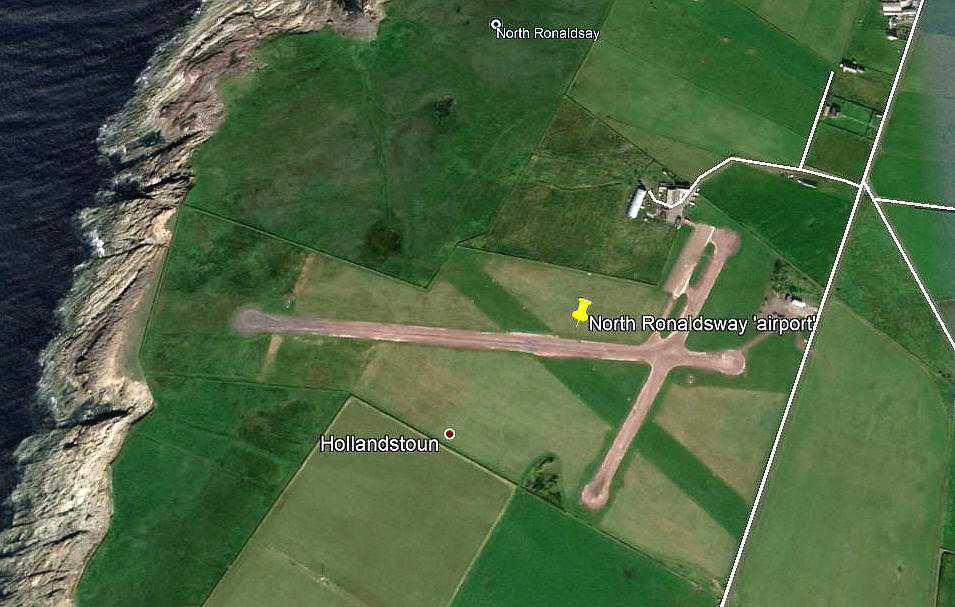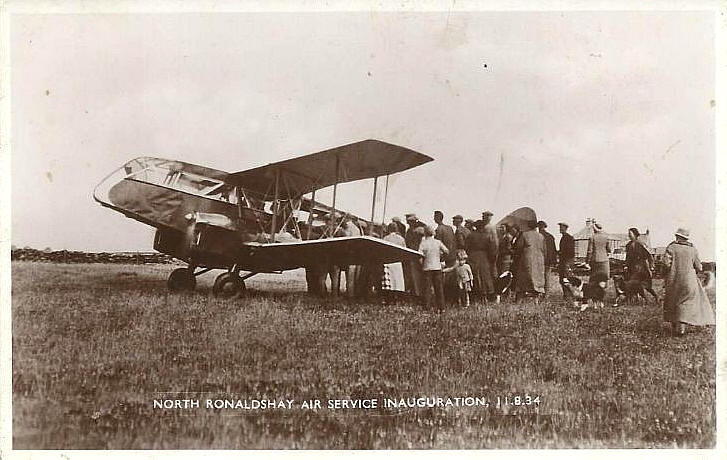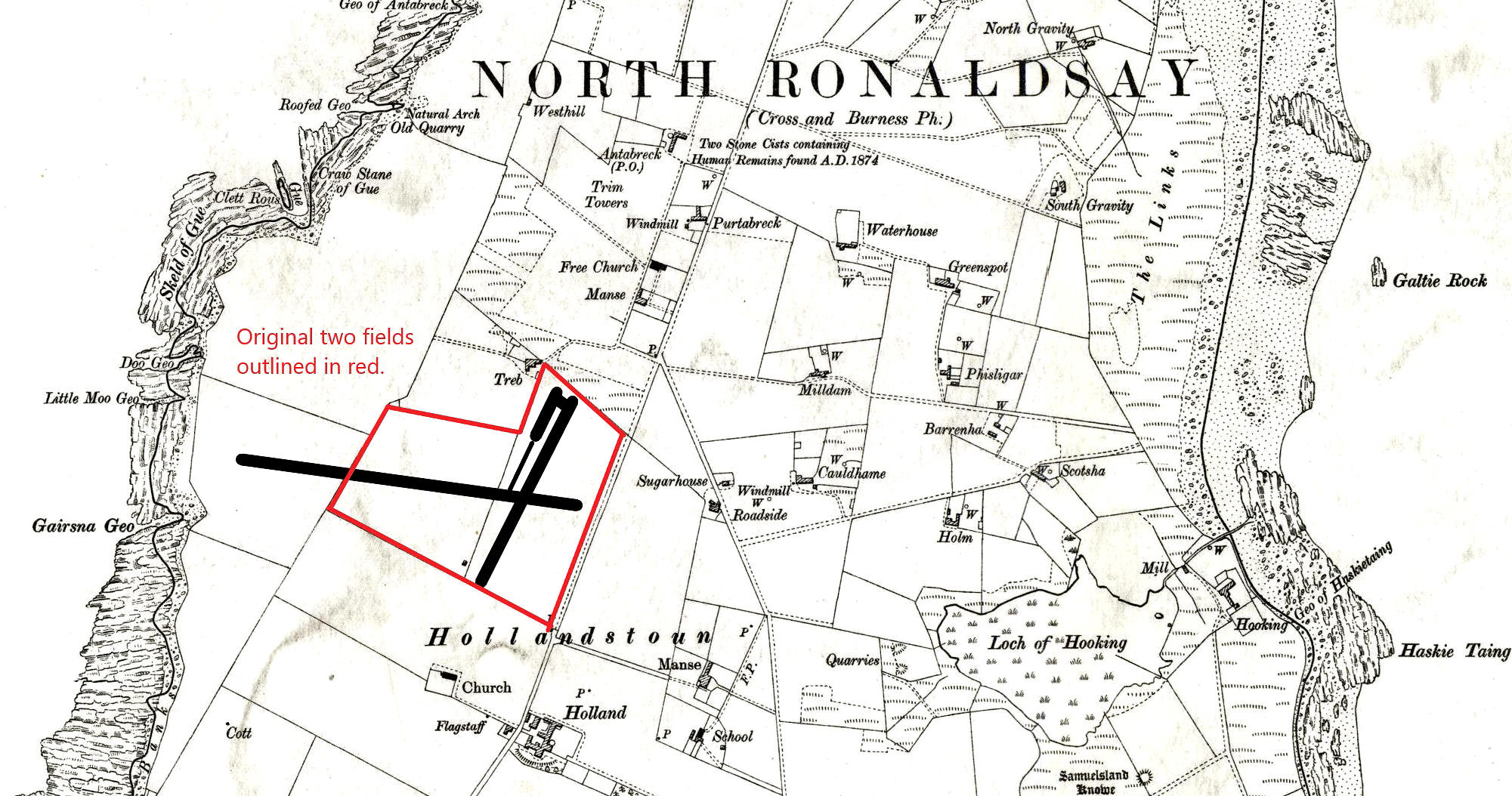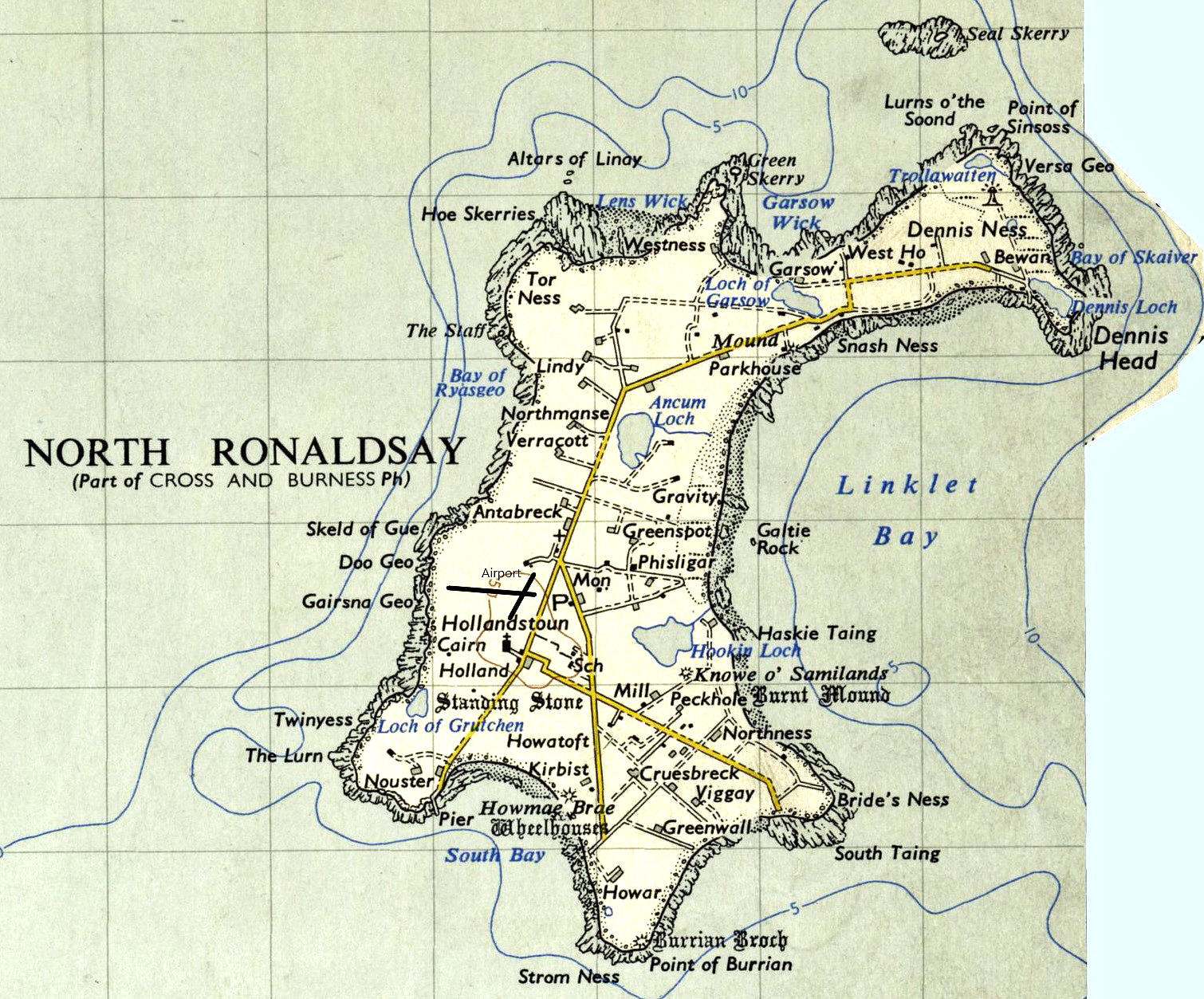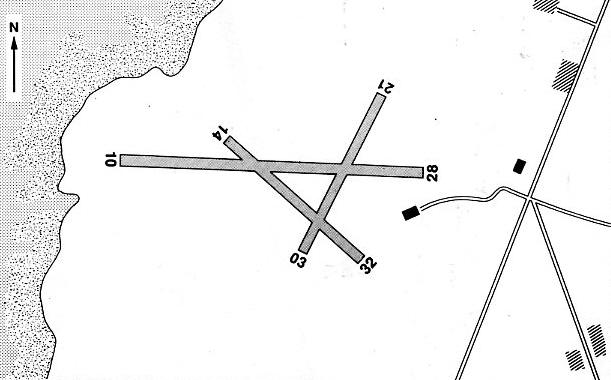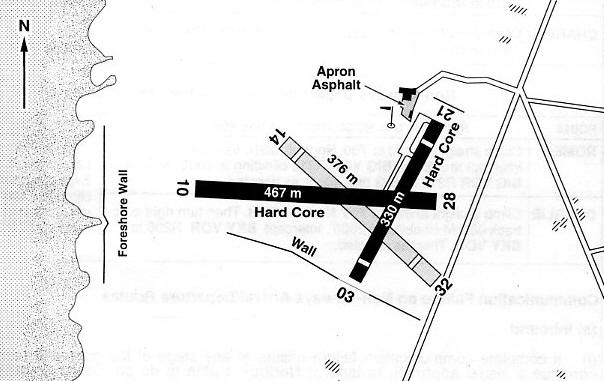North Ronaldsay
NORTH RONALDSAY: Civil aerodrome & regional airport (Aka NORTH RONALDSHAY initally)
Note: This first picture (2015) was obtained from Google Earth ©. The second picture is kindly reproduced c/o The Orkney Library
Operated by: 1930s: Highland Airways (But….did they use this site?)
Note: In June 2020 Mr Michael T Holder, a great friend of this 'Guide' found that they did indeed, and supplied these maps.
1980s to 2000: Orkney Islands Council
British airline users: Pre 1940: Highland Airways
Post 1945: BEA, Loganair
Location: See map.
Period of operation: 1930s to 2001?
Note: These maps are reproduced with the kind permission of Pooleys Flight Equipment Ltd. Copyright Robert Pooley 2014.
Runways: 1990: 10/28 519x30 grass 14/32 305x30 grass
04/22 305x30 grass
2000: 10/28 467x18 hard 14/32 376x30 grass
03/21 330x18 hard core
NOTES:
Mike Holder has found accounts of Capt. Fresson visiting the island on the 24th December 1933. An account was published in the Orkney Herald on the 3rd January 1934. No proof that Fresson landed exactly here of course, but he was on his way to Kirkwall via Sanday and Westray. Almost certainly flying one of his Highland Airways DH84 Dragons, either G-ACCE or G-ACIT. This example being named 'Inverness' it seems.
What does seem certain is that the islanders converted two fields into a 28 acre airfield, flat and obstruction free, in just one day. Indeed, Mike Holder has unearthed this account from the Orkney Herald published on the 18th July 1934 concerning a visit by Fresson on the 12th July.
AIR-MINDED ISLANDERS
"On Thursday afternoon all roads led to the aerodrome, where Capt. Fresson was giving "joy flips" with the Highland Airways, Ltd, airplane Inverness. It was a little after 5 o'clock when the airplane arrived, and the first to be honoured with flips were the schoolboys who had gathered loose stones from the aerodrome. This being finished there was no lack of joy riders, male and female, young and old, until nearly 8 o'clock, when the 'plane took its departure."
"Before taking off Capt. Fresson said that he was well pleased with the air-mindedness of the North Ronaldshay people, and thanked them very much for their support. He also spoke highly of the landing field, saying it was the best in the islands, and asked for a show of hands from those who would be in favour of an inter-island service to Kirkwall, which he proposes to try in the near future. This also met with good support."
The Aberdeen Press and Journal on the 8th August 1934 reported the new Orkney inter-island air service was opened on the 7th August, by Captain E E Fresson managing director of Highland Airways arriving at Kirkwall with a Dragon twin-engine seven-seater, (My note: Six I think, the pilot not being a passenger!). It appears the service would operate on Mondays and Saturdays, connecting Kirkwall with North Ronaldsway, Stronsay, Sanday and Westray. The first scheduled service to North Ronaldsway was, it appears, on the 11th August 1934.
ANOTHER DISCOVERY
Mike Holder also found this account from the Aberdeen Press and Journal published on the 1st August 1939. Warning! Unless you have a penchant for making your brain hurt, please avoid investigating the history of airlines in Scotland during the 1930s.
MAKING AIR MAIL HISTORY IN ORKNEY
"Post Office history was made in the Orkney Islands yesterday afternoon when Captain E.E. Fresson, managing director at Inverness for Scottish Airways, Limited, piloted the first general air mail plane on the British Isles Internal Services. The plane links Kirkwall with North Ronaldshay, the most northerly island of the Orkney Group."
"Parcels, newspapers, printed matter and postcards are carried at ordinary rates, whereas the air mail services linking the Orkney Islands with Inverness, and the Shetland Islands and Aberdeen, still carry first-class only - that is to say, letters only."
AND YET MORE
Mike Holder also unearthed this account from the Scotsman, published on Wednesday 15th January 1947.
ISLAND MAILS BY AIR
Post Office Charters 'Plane
PASSENGERS ALSO CARRIED
"FLYING without a wireless operator and doing his own radio work, Captain E. E. Fresson, North of Scotland manager of British European Airways relieved the beleaguered Orkney island of North Ronaldsay by making three flights from Kirkwall. The first flight was on charter by the Post Office, and he took 700 lbs of mail out, fetching 460 lbs back. The first landing on North Ronaldsway was described by an island correspondent as the most sensational ever seen on the island."
"The airfield, now seldom used, was flooded in parts after the recent torrential rain. On its dry patches there were hundreds of sheep. Captain Fresson had to circle the island till the islanders cleared off the sheep to allow him making a landing. He took off successfully with the outward mail, an accumulation of two weeks, during which ships had failed to call. He had also a number of pasengers."
"On his second flight, Captain Fresson carried to North Ronaldsway, among others, the island teacher, a week late after her holiday. The third flight carried one passenger each way."
BEA, (British European Airways Corporation), was founded on the 1st January 1946! So clearly something needs to be explained here as to why it took so long for BEA to reach NORTH RONALDSWAY? One answer, it would seem, after reading several accounts concerning BEA operations in Scotland, is that they had no interest in providing a comprehensive service to the region, (i.e. Scotland), preferring to concentrate on routes with the maximum revenue potential. Which I suppose is fair enough in those times, they were after all expected to make a profit. This said, BEA did operate a large number of air ambulance operations. See below.
MORE INFO
Iain Hutchison gives this account in his excellent book Air Ambulance. “Rapide G-AHVX landed at North Ronaldsay on an ambulance flight on 15th January 1949. The grass strip was severely waterlogged and the aircraft was badly damaged when it made contact with the ground. It was considered beyond repair and in future BEA preferred to avoid these rough strips whenever possible.”
I think it is fair to say this tells us a lot about the regime BEA had set in place; they were ill-equipped – certainly at management level, to undertake this work. Which begs the question why they were, in the first place, even given the task of managing the Scottish airline network? Without any doubt BEA was, in many respects at senior management level, at best incompetent, (this applied to virtually every aspect of that airline), and indeed the quality of the air ambulance service suffered greatly - and would only improve once Loganair got involved using Britten-Norman Islanders.
However, the previous comments must not be taken as reflecting on the commitment of all the people concerned with operations most of whom, if not all, demonstrated a remarkable degree of skill and fortitude. Whoever made the decision to use the DH.114 Heron for duties at the smallest of airfields, many of which could then not be safely used, should surely be named and shamed. What I fail to understand is why the Scottish Aviation Twin Pioneer, (being produced at PRESTWICK), wasn't deemed a far more suitable type for the smaller and rougher airfields. Perhaps somebody with actual experience on the Twin Pioneer could be kind enough to explain why it wasn't deemed suitable?
Much of this sad history of BEA, being a nationalised airline, revolves around political interference and the appointment of some very dubious people to lead it. (See SOLLAS, INVERNESSHIRE for more information)
In at least one flight guide a warning is given because the ‘main’ runway 10/28 is Graded Hard Core and therefore unsuitable for use for light aircraft with low ground/propeller clearance due to the unstabilised surface. One year later in another flight guide it is described as being grass! In 1990 it was said that scheduled services operated on Mondays, Wednesdays, Fridays and Saturdays.
We'd love to hear from you, so please scroll down to leave a comment!
Leave a comment ...
Copyright (c) UK Airfield Guide















